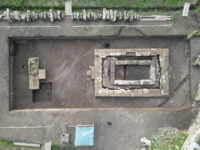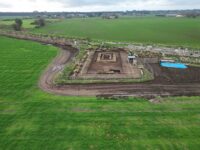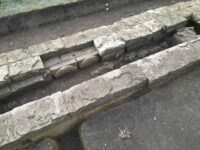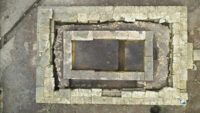 The remains of two new temples in Doric style have been discovered in the ancient Greek colony of Poseidonia (renamed Paestum by the Romans when they conquered it in 273 B.C.) in southern Italy. Only the base of one dating to the 5th century B.C. remains intact. The remains of the older temple were incorporated into it.
The remains of two new temples in Doric style have been discovered in the ancient Greek colony of Poseidonia (renamed Paestum by the Romans when they conquered it in 273 B.C.) in southern Italy. Only the base of one dating to the 5th century B.C. remains intact. The remains of the older temple were incorporated into it.
 The temples were discovered unexpectedly during an excavation campaign on the western side of the city near the ancient walls. The goal was the document the stratigraphy of the area, and archaeologists had no inkling there were temple remains to be found. The first traces of the first temple were encountered in June 2019, with a thorough investigation beginning in September 2022. That temple dates to the first decades of the 5th century B.C. The parts of it that are preserved today are the foundation of the columns (the stylobate) and the steps (crepidoma). It measures 38 by 25 feet and its peristatis (the four sides of columns surrounding the cella, the inner chamber space where the image of the deity was venerated) had six columns on the long sides and four on the short. These dimensions and architectural features are unique for a Doric temple.
The temples were discovered unexpectedly during an excavation campaign on the western side of the city near the ancient walls. The goal was the document the stratigraphy of the area, and archaeologists had no inkling there were temple remains to be found. The first traces of the first temple were encountered in June 2019, with a thorough investigation beginning in September 2022. That temple dates to the first decades of the 5th century B.C. The parts of it that are preserved today are the foundation of the columns (the stylobate) and the steps (crepidoma). It measures 38 by 25 feet and its peristatis (the four sides of columns surrounding the cella, the inner chamber space where the image of the deity was venerated) had six columns on the long sides and four on the short. These dimensions and architectural features are unique for a Doric temple.
 The excavation is ongoing now, and just a few weeks ago, archaeologists found the remains of an even older temple. Beneath the peristasis are 14 fragmentary column capitals and other assorted architectural materials that were reused in the construction of the 5th century B.C. temple. They are about the same size as the columns of the small temple would have been, but of a different type comparable to the Doric capitals in the Temple of Hera, the oldest of Paestum’s temples. That means a temple from the 6th century B.C. precedes the one unearthed in 2022. It was replaced, likely after a collapse, and its usable pieces recycled into the new sacred structure.
The excavation is ongoing now, and just a few weeks ago, archaeologists found the remains of an even older temple. Beneath the peristasis are 14 fragmentary column capitals and other assorted architectural materials that were reused in the construction of the 5th century B.C. temple. They are about the same size as the columns of the small temple would have been, but of a different type comparable to the Doric capitals in the Temple of Hera, the oldest of Paestum’s temples. That means a temple from the 6th century B.C. precedes the one unearthed in 2022. It was replaced, likely after a collapse, and its usable pieces recycled into the new sacred structure.
 This discovery sheds new light on the early timeline of the site and of the city’s layout. The excavation found evidence that the internal walls of the city had collapsed, hitting the 5th century temple and damaging part of it. A road was found underneath the collapsed wall, indicating that in the 6th century B.C. when the earliest of the two small temples was built, the city did not yet have defensive walls.
This discovery sheds new light on the early timeline of the site and of the city’s layout. The excavation found evidence that the internal walls of the city had collapsed, hitting the 5th century temple and damaging part of it. A road was found underneath the collapsed wall, indicating that in the 6th century B.C. when the earliest of the two small temples was built, the city did not yet have defensive walls.
During a period of significant growth of the polis, the colonists of Poseidonia built a sanctuary in a strategic location. It protected the urban space and was directly visible from the sea. The importance of this sacred space is confirmed by its complex building phases, which saw the construction of two Doric temples. Its uninterrupted use, spanning over half a millennium, marks a fundamental continuity of worship through the Greco-Lucanian and Roman eras.
* This article was originally published here












No comments:
Post a Comment